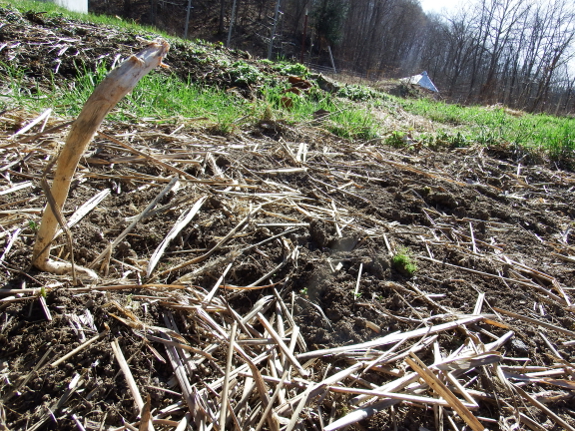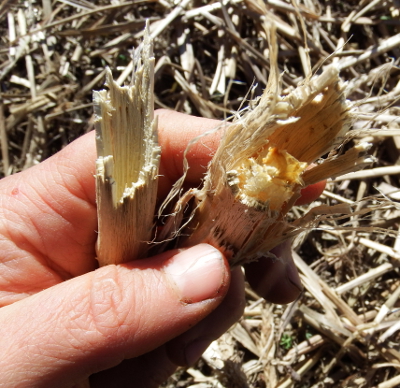
Easy soil microorganism test

Did you ever wonder
whether you have a healthy microorganism population in your soil?
There's a simple way to check. Assuming you haven't tilled up the ground
since last year's garden, you can go out at this time of year and look for stems of fall broccoli.
 I
usually find one or two broccoli stems just barely standing at this
time of year, with the rest having dissolved completely into the soil.
When I break the remaining stems apart, I see that the once-woody debris
will soon have disappeared into the ground as well. On the other hand,
if I still saw lots of standing broccoli stems when the time came to
plant peas and cabbages, I'd start worrying that I'd done something to
get the microorganism population out of whack.
I
usually find one or two broccoli stems just barely standing at this
time of year, with the rest having dissolved completely into the soil.
When I break the remaining stems apart, I see that the once-woody debris
will soon have disappeared into the ground as well. On the other hand,
if I still saw lots of standing broccoli stems when the time came to
plant peas and cabbages, I'd start worrying that I'd done something to
get the microorganism population out of whack.
Of course, you don't have to plant fall broccoli to test your microorganism levels. Cover crops
also do a fine job as well. In beds where I planted oilseed radishes
last fall, there's now almost no debris left on top of the ground,
simply a nearly weed-free patch of soil waiting for the spring onion
planting. Oat beds tend to still have some debris left at this time of
year, but even that will be largely gone by our frost-free date.
I'd be curious to hear
from our readers. Do your fall broccoli plants melt into the ground by
early April (or by May for those of you who live way up north)?
Want more in-depth information? Browse through our books.
Or explore more posts by date or by subject.
About us: Anna Hess and Mark Hamilton spent over a decade living self-sufficiently in the mountains of Virginia before moving north to start over from scratch in the foothills of Ohio. They've experimented with permaculture, no-till gardening, trailersteading, home-based microbusinesses and much more, writing about their adventures in both blogs and books.
Want to be notified when new comments are posted on this page? Click on the RSS button after you add a comment to subscribe to the comment feed, or simply check the box beside "email replies to me" while writing your comment.

I, like you, have had that experience too. Do you always keep your cut plants' roots in the ground in the fall for over the winter or do you sometimes uproot plants? I have done both, wondering which is actually better practice for respecting the soil health and life. Same about "weeds" (I make use of wild plants too, so find it difficult to call anything a weed now), do use a hoe to cut off the tops and leave the roots in place or do you uproot? In response to the previous comment about the "green worms", are you referring to cabbage moth larva/caterpillars? I do find that a constant issue, especially wanting to support biodiversity in all its forms. Some years, when they were in large numbers, and killing my plants, I have had to try to relocate the caterpillars to wild mustard plants by cutting and moving them on the already chewed up broccoli leaves. I have also heard that garlic and chili powder on the leaves will keep the moths from landing and laying eggs.